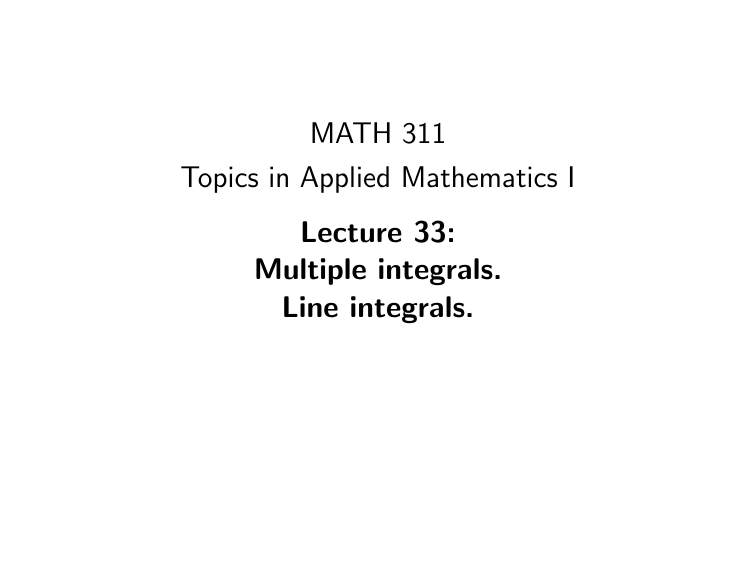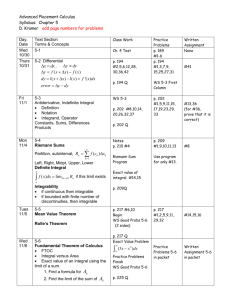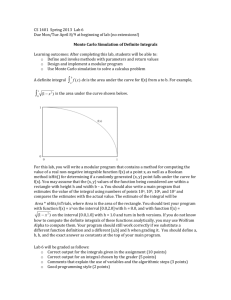MATH 311 Topics in Applied Mathematics I Lecture 33: Multiple integrals.
advertisement

MATH 311
Topics in Applied Mathematics I
Lecture 33:
Multiple integrals.
Line integrals.
Riemann sums in two dimensions
Consider a closed coordinate rectangle
R = [a, b] × [c, d ] ⊂ R2 .
Definition. A Riemann sum of a function f : R → R with
respect to a partition P = {D1 , D2 , . . . , Dn } of R generated
by samples tj ∈ Dj is a sum
Xn
f (tj ) area(Dj ).
S(f , P, tj ) =
j=1
The norm of the partition P is kPk = max1≤j≤n diam(Dj ).
Definition. The Riemann sums S(f , P, tj ) converge to a limit
I (f ) as the norm kPk → 0 if for every ε > 0 there exists
δ > 0 such that kPk < δ implies |S(f , P, tj ) − I (f )| < ε for
any partition P and choice of samples tj .
If this is the case, then the function f is called integrable on
R and the limit I (f ) is called the integral of f over R.
Double integral
Closed coordinate rectangle R = [a, b] × [c, d ]
= {(x, y ) ∈ R2 | a ≤ x ≤ b, c ≤ y ≤ d }.
ZZ
ZZ
Notation:
f dA or
f (x, y ) dx dy .
R
R
Theorem 1 If f is continuous on the closed
rectangle R, then f is integrable.
Theorem 2 A function f : R → R is Riemann
integrable on the rectangle R if and only if f is
bounded on R and continuous almost everywhere on
R (that is, the set of discontinuities of f has zero
area).
Fubini’s Theorem
Fubini’s Theorem allows us to reduce a multiple
integral to a repeated one-dimensional integral.
Theorem If a function f is integrable on
R = [a, b] × [c, d ], then
ZZ
Z b Z d
f dA =
f (x, y ) dy dx
R
a
=
c
Z d Z
c
b
f (x, y ) dx dy .
a
In particular, this implies that we can change the
order of integration in a repeated integral.
Integrals over general domains
Suppose f : D → R is a function defined on a
(Jordan) measurable set D ⊂ R2 . Since D is
bounded, it is contained in a rectangle R. To
define the integral of f over D, we extend the
function f to a function on R:
f (x, y ) if (x, y ) ∈ D,
ext
f (x, y ) =
0
if (x, y ) ∈
/ D.
ZZ
ZZ
Definition.
f dA is defined to be
f ext dA.
D
In particular, area(D) =
R
ZZ
1 dA.
D
Integration as a linear operation
Theorem 1 If functions f , g are integrable on a
set D ⊂ R2 , then the sum f + g is also integrable
on D Zand
Z
ZZ
ZZ
(f + g ) dA =
f dA +
g dA.
D
D
D
Theorem 2 If a function f is integrable on a set
D ⊂ R2 , then for each α ∈ R the scalar multiple
αf is also integrable on D and
ZZ
ZZ
αf dA = α
f dA.
D
D
Comparison theorems for integrals
Theorem 1 If functions f , g are integrable on a
set D ⊂ R2 , and f (x, y ) ≤ g (x, y ) for all
(x, y ) ∈ D, then
ZZ
ZZ
f dA ≤
g dA.
D
D
Theorem 2 If f is integrable on a set D ⊂ R2 ,
then the function |f | is also integrable on D and
ZZ
Z Z
≤
f
dA
|f | dA.
D
D
More properties of integrals
Theorem If a function f : D → R is integrable on
the set D ⊂ R2 and f (D) ⊂ [a, b], then for each
continuous function g : [a, b] → R the composition
g ◦ f is also integrable on D.
Theorem If a function f is integrable on sets
D1 , D2 ⊂ R2 , then it is integrable on their union
D1 ∪ D2 . Moreover, if the sets D1 and D2 are
disjoint up to a set of zero area, then
ZZ
ZZ
ZZ
f dA.
f dA +
f dA =
D1 ∪D2
D1
D2
Change of variables in a double integral
Theorem Let D ⊂ R2 be a measurable domain
and f be an integrable function on D. If
T = (u, v ) is a smooth coordinate mapping such
that T−1 is defined on D, Then
ZZ
f (u, v ) du dv
D
ZZ
∂(u,
v
)
dx dy .
=
f u(x, y ), v (x, y ) det
∂(x,
y
)
−1
T (D)
In particular, the integral in the right-hand side is
well-defined.
Triple integral
To integrate in R3 , volumes are used instead of areas in R2 .
Instead of coordinate rectangles, basic sets are coordinate
boxes (or bricks) B = [a1 , b1 ] × [a2 , b2 ] × [a3 , b3 ] ⊂ R3 .
Then we can define an integral of a function f over a
measurable set D ⊂ R3 .
ZZZ
ZZZ
Notation:
f dV or
f (x, y , z) dx dy dz.
D
D
The properties of triple integrals are completely analogous to
those of double integrals. In particular, Fubini’s Theorem is
formulated as follows.
Theorem If a function f is integrable on a brick
B = [a1 , b1 ] × [a2 , b2 ] × [a3 , b3 ] ⊂ R3 , then
ZZZ
Z b1 Z b2 Z b3
f dV =
f (x, y , z) dz dy dx.
B
a1
a2
a3
Path
Definition. A path in Rn is a continuous function
x : [a, b] → Rn .
Paths provide parametrizations for curves.
Length ofP
the path x is defined as
L = supP kj=1 kx(tj ) − x(tj−1)k over all partitions
P = {t0 , t1, . . . , tk } of the interval [a, b].
Theorem The length
Z b of a smooth path
x : [a, b] → Rn is
kx0 (t)k dt.
a
Arclength parameter: s(t) =
Z
t
kx0 (τ )k d τ .
a
Scalar line integral
Scalar line integral is an integral of a scalar function f over a
path x : [a, b] → Rn of finite length relative to the arclength.
It is defined as a limit of Riemann sums
Xk
S(f , P, τj ) =
f (x(τj )) s(tj ) − s(tj−1 ) ,
j=1
where P = {t0 , t1 , . . . , tk } is a partition of [a, b],
τj ∈ [tj , tj−1 ] for 1 ≤ j ≤ k, and s is the arclength parameter
of the path x.
Theorem Let x : [a, b] → Rn be a smooth path and f be a
function defined on the image of this path. Then
Z
Z b
f ds =
f (x(t)) kx0(t)k dt.
x
a
ds is referred to as the arclength element.
Vector line integral
Vector line integral is an integral of a vector field
over a smooth path. It is a scalar.
Definition. Let x : [a, b] → Rn be a smooth path
and F be a vector
Z field defined
Z b on the image of this
path. Then
F · ds =
F(x(t)) · x0(t) dt.
x
a
Alternatively, the integral of F over x can be
represented
Z as the integral of a differential form
F1 dx1 + F2 dx2 + · · · + Fn dxn ,
x
where F = (F1, F2 , . . . , Fn ) and dxi = xi0 (t) dt.
Line integrals and reparametrization
Given a path x : [a, b] → Rn , we say that another path
y : [c, d ] → Rn is a reparametrization of x if there exists a
continuous invertible function u : [c, d ] → [a, b] such that
y(t) = x(u(t)) for all t ∈ [c, d ].
The reparametrization may be orientation-preserving (when u
is increasing) or orientation-reversing (when u is decreasing).
Theorem 1 Any scalar line integral is invariant under
reparametrizations.
Theorem 2 Any vector line integral is invariant under
orientation-preserving reparametrizations and changes its sign
under orientation-reversing reparametrizations.
As a consequence, we can define the integral of a function
over a simple curve and the integral of a vector field over a
simple oriented curve.






